Subscribe to our ▶️ YouTube channel 🔴 for the latest videos, updates, and tips.
Subtraction of 3-Digit Numbers without Regrouping
Subtraction of 3-digit numbers without regrouping are explained here with examples.
1. Ron has a ream of paper having 140 sheets in it. He has used 40 sheets for his project report. How many sheets are left in the ream?
Solution:
|
To find out the number of sheets left, we will perform subtraction. To subtract 3-digit numbers, the numbers are written one below the other. While subtracting 3 digit number, we subtract ones digit first, then tens digit and finally the hundreds digit. |
So, 100 pages are left with Ron.
2. Subtract 354 from 699.
|
Solution: Step I: Arrange the numbers vertically. Step II: First subtract the ones column. 9 - 4 = 5 Step III: Now, subtract the tens column. 9 – 5 = 4 Lastly, subtract the hundreds column. 6 – 3 = 3 |
Thus, 699 – 354 = 345
3. Subtract 312 from 653.
Step I: Arrange the number in coloumns of tens and ones.
Step II: Subtract ones.
Step III: Then, subtract tens.
Step IV: At last, subtract hundreds.
4. Subtract 423 from 687.
Step I: Arrange the numbers in hundreds, tens and ones.
H T O
6 8 7
- 4 2 3
____________
Step II: Subtract the ones.
H T O
6 8 7
- 4 2 3
4
Step III: Subtract the tens.
H T O
6 8 7
- 4 2 3
6 4
Step III: Subtract the hundreds.
H T O
6 8 7
- 4 2 3
2 6 4
Thus, 687 - 423 = 264
5. Let us subtract 136 from 459.
Write the numbers one below the other as shown.
Step I: Subtract the ones.
9 ones - 6 ones = 3 ones
Write 3 in the ones place.
Step II: Subtract the tens.
5 tens - 3 tens = 2 tens
Write 2 in the tens place.
Step III: Subtract the hundreds.
4 hundreds - 1 hundred = 3 hundreds
Write 3 in the hundreds place.
The difference is 323.
6. A train carried 389 passengers. At a station, 272 of them got off. How many passengers were left in the train?
Solution:
389 - 272 = ?
So, 117 passengers are left in the train.
Worksheet on Subtraction of 3-Digit Numbers without Regrouping:
I. Subtract the following 3-Digit Numbers without Regrouping:
|
(i) H T O 3 4 4 - 1 2 ____________ |
(ii) H T O 4 6 8 - 3 4 ____________ |
|
(iii) H T O 8 8 8 - 2 1 ____________ |
(iv) H T O 2 8 6 - 5 0 ____________ |
|
(v) H T O 9 3 2 - 2 0 ____________ |
(vi) H T O 6 7 8 - 1 6 ____________ |
|
(vii) H T O 7 6 8 - 5 2 ____________ |
(viii) H T O 8 4 5 - 2 1 ____________ |
|
(ix) H T O 9 3 9 - 1 7 ____________ |
(x) H T O 5 2 6 - 1 5 ____________ |
|
(xi) H T O 3 6 5 - 4 4 ____________ |
(xii) H T O 8 4 5 - 4 3 2 ____________ |
|
(xiii) H T O 2 4 3 - 1 2 2 ____________ |
(xiv) H T O 7 5 4 - 2 1 2 ____________ |
|
(xv) H T O 8 3 5 - 8 3 4 ____________ |
(xvi) H T O 8 7 6 - 2 2 1 ____________ |
|
(xvii) H T O 4 5 7 - 2 3 5 ____________ |
(xviii) H T O 9 9 9 - 3 3 3 ____________ |
|
(xix) H T O 7 4 7 - 3 2 4 ____________ |
(xx) H T O 8 7 8 - 4 2 5 ____________ |
|
(xxi) H T O 9 7 5 - 3 6 1 ____________ |
(xxii) H T O 8 6 7 - 3 3 4 ____________ |
Answer:
I. (i) 332
(ii) 434
(iii) 867
(iv) 236
(v) 912
(vi) 662
(vii) 716
(viii) 824
(ix) 922
(x) 511
(xi) 321
(xii) 413
(xiii) 121
(xiv) 542
(xv) 1
(xvi) 655
(xvii) 222
(xviii) 666
(xix) 423
(xx) 453
(xxi) 614
(xxii) 533
II. Subtract the following Numbers as shown:
|
(i) |
H T O 2 4 9 - 3 1 __2___1___8_ |
(ii) |
H T O 8 8 2 - 7 1 ____________ |
|
(iii) |
H T O 7 5 6 - 3 1 ____________ |
(iv) |
H T O 6 9 5 - 2 2 3 ____________ |
|
(v) |
H T O 4 8 7 - 3 2 7 ____________ |
(vi) |
H T O 7 4 3 - 4 2 2 ____________ |
|
(vii) |
H T O 3 4 9 - 2 6 0 ____________ |
(viii) |
H T O 8 7 4 - 2 7 2 ____________ |
|
(ix) |
H T O 9 6 8 - 4 4 5 ____________ |
(x) |
H T O 6 4 6 - 2 2 2 ____________ |
|
(xi) |
H T O 9 9 5 - 6 3 1 ____________ |
(xii) |
H T O 8 5 7 - 4 1 5 ____________ |
Answer:
II. (ii) 811
(iii) 725
(iv) 472
(v) 160
(vi) 321
(vii) 134
(viii) 602
(ix) 523
(x) 424
(xi) 364
(xii) 442
III. Subtract the following without Regrouping:
(i) 587 - 63
(ii) 864 - 54
(iii) 734 - 22
(iv) 468 - 105
(v) 351 - 30
(vi) 536 - 105
(vii) 227 - 106
(viii) 679 - 253
(ix) 783 - 260
(x) 975 - 342
(xi) 666 - 510
(xii) 897 - 451
(xiii) 793 - 482
(xiv) 503 - 200
(xv) 742 - 630
(xvi) 438 - 104
(xvii) 679 - 234
(xviii) 868 - 536
(xix) 568 - 122
(xx) 389 – 324
Answer:
III. (i) 524
(ii) 810
(iii) 712
(iv) 363
(v) 321
(vi) 431
(vii) 121
(viii) 426
(ix) 523
(x) 633
(xi) 156
(xii) 446
(xiii) 311
(xiv) 303
(xv) 112
(xvi) 334
(xvii) 445
(xviii) 332
(xix) 446
(xx) 65
IV. Subtract the numbers without Regrouping:
(i) 453 - 41
(ii) 536 - 12
(iii) 846 - 34
(iv) 973 - 642
(v) 128 - 128
(vi) 810 - 600
(vii) 685 - 430
(viii) 786 - 243
(ix) 498 - 303
Answer:
IV. (i) 412
(ii) 524
(iii) 812
(iv) 331
(v) 0
(vi) 210
(vii) 255
(viii) 543
(ix) 195
V. Do these sum in your notebook:
(i) 555 - 34
(ii) 286 - 50
(iii) 957 - 25
(iv) 634 - 23
(v) 473 - 31
(vi) 586 - 33
(vii) 735 - 12
(viii) 867 - 34
(ix) 268 - 117
(x) 698 - 454
(xi) 345 - 124
(xii) 758 - 631
(xiii) 368 - 256
(xiv) 579 - 254
(xv) 299 - 155
(xvi) 797 - 555
Answer:
V. (i) 521
(ii) 236
(iii) 932
(iv) 611
(v) 442
(vi) 553
(vii) 723
(viii) 833
(ix) 151
(x) 244
(xi) 221
(xii) 127
(xiii) 112
(xiv) 325
(xv) 144
(xvi) 242
From Subtraction of 3-Digit Numbers without Regrouping to HOME PAGE
Didn't find what you were looking for? Or want to know more information about Math Only Math. Use this Google Search to find what you need.
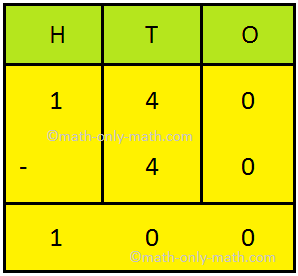
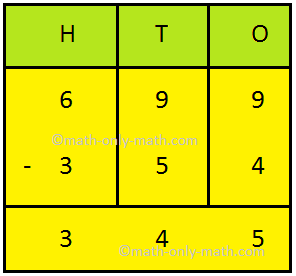

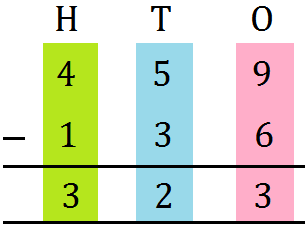
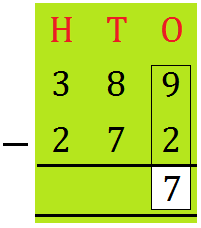
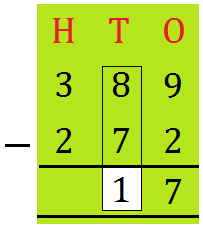
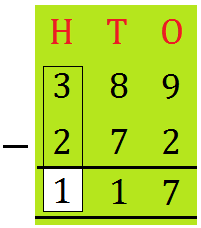


New! Comments
Have your say about what you just read! Leave me a comment in the box below. Ask a Question or Answer a Question.